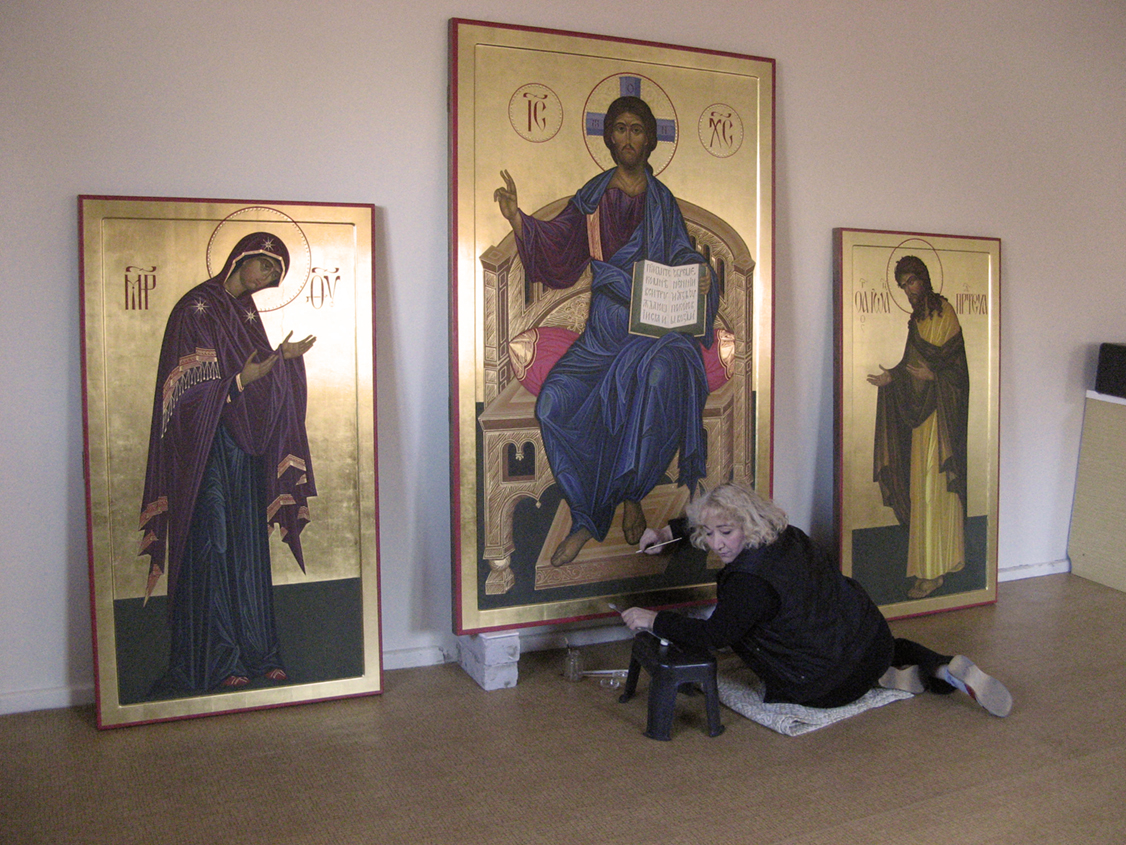How is icon born?
No matter whether we celebrate Christmas by Julian or Gregorian calendar, the big Christian holiday for many of us is a rare and probably the only occasion to visit the church and light a candle under the icon.
But the symbolism of icons remains difficult for understanding, and many would like to know more about the Christian culture.
We had the chance to speak to Olga Kirichenko, a person who day by day creates the holy image. How the icon is painted? Why are technics important? Is freedom of creativity possible in the icon-painting? How to choose a good icon?
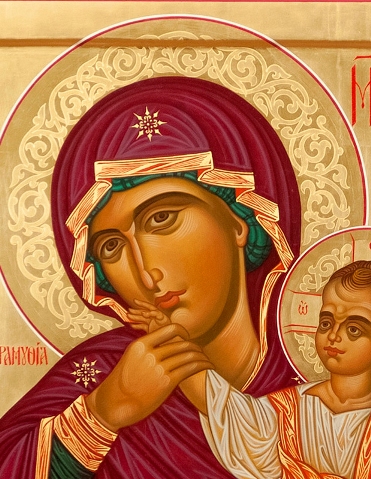
— Everyone understands icon in their different way. Icon either can attract or can be unappreciated. How to look at the icon, how to get its message?
— All of us have beloved ones. And we want them to be always fine. We wish their life was not only full of hard work and challenge, but also peace, care and genuine love. «Love that is mercy, not envious and not arrogant. Love that never ends».
Maybe icon should be approached with thoughts about love. Look at the icon of Saviour, and you will see Love. Look at the icon of Our Lady, and you will see Love, lively and eternal. That’s difficult to translate into words. Maybe not from the first approach, but you will gradually explore the sense of love that saves our human nature, in sacrificial and humble simplicity of Mother. Let the icons of other saints not to confuse you, as every icon (even if it does not bring the image of Christ) is Christocentric and its main message is Love.
— What icon painting is for, if all arts speaks about love?
— I can’t be a judge for artists, at least because of great variety of artistic trends. We do not deny design, we appreciate flowing shapes of Rolls-Royce or charm of impressionists. However the myth of artists being above the judgement became an ugly phenomenon of our reality. One’s actual dialog with the world, one’s fragile individualism, one’s private life being sold insteadof one’s art. Secular arts are dependable on cultural industry. If so, some buyers might be misled. One buys «big name», but the artwork does not make them happy. Do you think this is impossible? I can’t admire the freedom of of «revolutionary» exhibitions, epatage for epatage’s sake. Some exhibitions exposed artworks made of manure, but what does it all have to do with the arts?
— Many believe icons to be a conservative type of fine arts. And some consider icon painting not to be arts at all.
— Ancient icon-painters, artists, who worked in fresco and mosaic techniques, used to live a spirit of their era, and painted with the spirit of their era. They have been spirit-seers and painted with spirit-seeing. Neither rules nor templates applied. Theological basis and one’s talent were applicable. In Byzantine, iconic style developed as theological, and historical at the same time. Christian art revealed highest achievements of human spirit
(Mosaics os Hagia Sophia, Daphny and Hosios Loukas Monasteries, Nea Moni of Chios, frescoes of Nerezi and Sopoćani, icons of Athos. What Fathers actually were talking about during the Second Council of Nicaea that established the very work of icon-painting? They have not discussed technology or vellum and tracings. They focused on the power of holy image, on the power of art.
Byzantine Art can be distinguished by periods: Macedonian period (IX–XI cent.), Komnenian age (XI–XV cent.), followed by Paleologan age (XIII–XV cent.) They are all different. From Spain to Georgia, various painting schools formed, and, for example, pre-Renaissance Romanesque art provided its own masterpieces different from holy images of Christian East. However, the canon was the same.
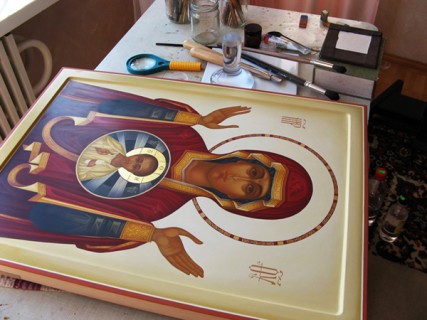
— Does iconic canon mean replication? Is the artist who creates better replicas considered to be better icon-painter?
Canonical tradition is not a rigid scheme requiring imitation. It has nothing to do with cloning. Good replica of high quality is a serious work and requires proper research. Replication work is sign of excellence. Precondition of replication of icon would be applying of same pigments and gluing solutions, as well as using the wooden board of same size as the original, and the authentic coating formula. Some certain work could include even reproduction of the loss of the paint layer or its reconstruction. It is necessary to understand the interplay of color in the mix. Both compatibility and neutrality of paints could be a key issue here. Blue mineral azurite mixed with malachite will end up as a pure green and would literally be turned into malachite. Simplier pigments, various ferreous compounds, glauconites, ochres are all steadiest. Samples of high quality should be scrutinized and replicated.
In iconic art, replication has one more meaning: this helps to touch the deepest content of holy image and to open special symbolic language of icon. Most of icons in churches are replicas created by various artists in different times. Modern icons are also replicas, as long as they maintain the continuity of the rich cultural heritage of the Church. And the most important here are width and depth of outlook, spirituality and talent of an icon-painter who makes replica to be an icon every time.
— You deny the importance of Black Square, which is said to have launched a cultural revolution? Kazimir Malevich named this work an «icon of our time». It became widely recognized and at the same time most mysterious and attractive in the modern art. So many debates and studies have been devoted to that work.
If Malevich was seeking for «zero» and found it in his Square, and even was himself terrified of what he found, then look through the window. Has God’s world disappeared after that?
So, Black Square has not proved the God’s non-existence. Black Square is not much. It’s just a level of unbelief of its creator and his followers. My icons speak about Love, Hope, Belief, and God’s truth is on my side.
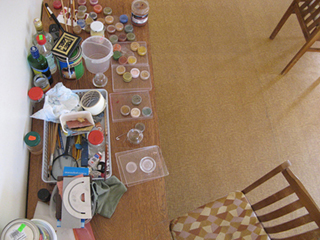
— Talking about modern icon, one often points that it is made using ancient technology. Does that really mean nothing better has been invented by now? Why canonical technology is still up-to-date?
These are not words just for effect. Ancient technology means painting with mineral pigments based on egg or wax emulsion. Being a practitioner, I understand the nature of minerals, their live temper. Crystal, glassy structure of minerals actively reflects sunlight. Ground in emulsion, they are laid down as smallest flakes, so that shards of crystals shine through each other. Like snow falling or ice freezing. Azurite and cinnobar have thinnest and most luminous flakes. Not by chance they used to say «painting with light» in past times. In orpiment these flat particles can be seen with the naked eye. Particles of other minerals can only be seen in the tempera effect.
Precious mineral named dioptase features same level of luminosity. A touch of dioptase, when used for colouring God Mothers’s clothes, makes them visually lifted and revived.
Natural colours harmonize on the golden background, they do not damp translucent gesso, finally, they are timeless. Sarcophagus of the Egyptians and the Assyrians, painted with azurite, still shine with victorious blue today. That’s the same paint, proven for thousands of years and being used in icons.
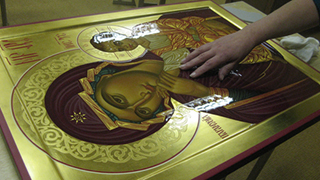
— Good icon for one’s family is life-long and serious purchase. It can be inherited as a treasure of dynasty. Icon can be a perfect valuable gift, as well as good investment. Bearing in mind that level of painting may vary from low to high, how would you recommend to choose a good icon of modern manufacture?
Let’s have a look on practical side. Where have you seen an icon of questionable quality? Was it in museum, in shop, in church or in icon-painter’s workshop? In permanent exhibition, you will definitely see a recognized masterpiece. In stalls you will hardly find an icon of proper quality, even if they sell painted works, not printed copies. Due to difficulty and high cost of the process of icon-painting, the painter won’t be able to sell it through the souvenirs shop, as such icon can’t match the price of average souvenir.
You can surely find a good icon in church, both antique and modern.
Painter’s workshop can be the place where the shoe pinches. Some can provide works of high level, but some of them can produce huge numbers of icons and do not care a lot about their quality. In decent workshop, you will meet painters with their artistic ego set far aside. As a rule, such artists can have not only refined skills, but also perfect souls and transmit the Lord’s idea through the purity of church tradition.
Choosing an icon, at least avoid things that disturb your eye: cheapness, posterness, indifference.
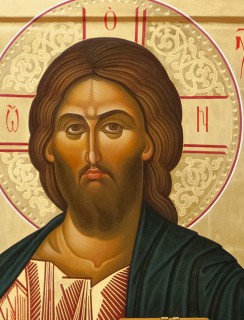
— Nevertheless, there have always been both works of fine art and average icons. What should one pay attention to?
Icons had always been favoured and created in great abundance in countries of Eastern Christianity, including Russia. However, at the turn of XVII–XVIII centuries the country entered «the era of manners». At that time icons were delivered to city markes with numerous carts. Icon-painting became dependable on tracings. Artworks were hidden behind luxury rizas which eventually started to indicate their value. Holy images literally sank in ornaments and decor, the power of painting and ease of painting being lost at the same time. Icons of that period are generally of much lower quality, speaking about their artistic and spiritual merit. Markets and auctions are still filled with works of that period.
Practices similar to those «manners» exist even today. What is, for example, «we will teach you how to paint an icon in two weeks» and other appeals. Quickies, created by someone as qualified as arts classes attendant, with superficial and simplified formulas in their mind. Of course, it results nothing but compromise of Christian art. Weak theological basis and lack of skills discredits icon-painting.
One can make a first judgement just looking on how elaborate the artwork is. Proper board of lime or cypress, oak dowells, good gilding are all signs of icon’s high quality. You can recognize real art by joy of perception. You will come back to the icon again and again. The image will attract you, but the feeling would be much deeper than joy of presence of your nearest and dearest, because much more immense and significant things will stand behind the icon.
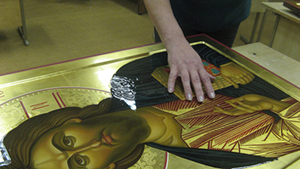
— Please tell us about your work and your creative lab.
Some unusual things used to happen in my work. One of my customers, a very respectable person, but of slightly rampant character, asked me to paint «strict-looking» Savior’s image, so that He had a stern glance. This of course has nothing to do with conjuncture, professional icon-painter will never go on about it. In this situation, there is a possibility to choose one of historical images and work on it. Let’s say, Mandylion Awesome Eye («Спас Ярое Око»), terrifying but merciful.

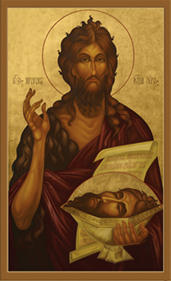
Right solution can be found for each case. I am guided by art of ancient painters, as well as research icons of earlier Christian times, paintings of catacombs, mosaics and frescoes of Delphi, in order to approach the fundamentals of visual arts of Byzantine and Ancient Russia.
Not to be unfounded, let’s compare two images of Saint John Baptist from Vvedensky church, town of Visaginas, Lithuania (prior of the church is Archpriest, Dr Iosif Zeteishvili). Many icons of St John reveal the image of austere ascetic. His poignant speeches had no mercy on powers that be. Icon dated 2000 from iconostasis of lower temple expresses the idea of asceticism and flame of spirit of great Prophet. In this very icon, this perception is supported by colour expression and a clear line of silhouette. St John Baptist’s icon dated 2013 emphasizes another aspect of his service, that is sacrifice, humility, depth of pray. These two images are of original design, they are unique but represent joint work of the church.
— There are nonetheless many rules in icon-painting. Are they mandatory? Or is that just mustiness and restriction on freedom of creativity?
That’s true, iconography sets definite rules and determines types of canonical images. This is respect towards history. For example, details of warriors’ shields, monks’ and kings’ dresses. Iconography had been developed gradually, there are certain types of images. God Mother alone has a few versions: Hodegetria, Oranta, Derzhavnaya, Eleusa, and that’s not a full list.
I love ancient good icon and try to understand its spiritual beauty. I feel happy everytime I see an icon. And the canon is to be referred not to miss something, to compare, to maintain authenticity and reverence, and then incarnate the image in new coordinate system.
— How to treat modern interpretations?
Can’t find any bad in the very word «interpretation» applied to the icon. Icon-painter, after prayer, creates an image, or co-creates. Replica of icon is more or less interpretation. If only Jesus is not painted in knitted cap holding ski in his hand… Anyway, kitch will be kitch, and icon will remain an icon.
By Vlad Smeathan
Photo by A.Musatov, V.Bogdanovich and from the archive of Olga Kirichenko
Olga Kirichenko was born in 1960 in Russia, lives and works in Visaginas, Lithuania. Having got her degree in arts from Kirov and Leningrad, she worked in icon-painting workshops in The Trinity Lavra of St. Sergius and Saint Alexander Nevsky Lavra in Saint Petersburg. Main works include iconostasis for Vvedensky church in Visaginas, iconostasis for the St Panteleimon’s aisle of Vvedensky church in Visaginas, icons for Church of St John the Baptist and for the church of St Nicholas in Vilnius, as well as for Christian communities and private collections of United Kingdom, United States and Lithuania.
